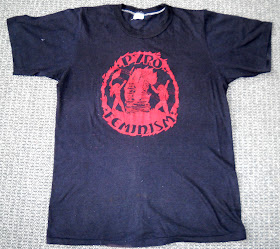 Looking through the glass case from the reading room, Rauner seems to be filled to the brim with rare books and manuscripts. While the library has its fair share of those, its shelves hold more than books. Our Realia collection, which supplements collections of books and manuscripts, has enough clothing to fill a walk-in closet. Unsurprisingly, with the number of free T-shirts Dartmouth doles out, one of the most popular items of clothing to enter Dartmouth's historical record is the humble T-shirt. What better to serve as a snapshot into the mindset of the students than the messages in words and images they have chosen to wear on their bodies at different points in time?
Looking through the glass case from the reading room, Rauner seems to be filled to the brim with rare books and manuscripts. While the library has its fair share of those, its shelves hold more than books. Our Realia collection, which supplements collections of books and manuscripts, has enough clothing to fill a walk-in closet. Unsurprisingly, with the number of free T-shirts Dartmouth doles out, one of the most popular items of clothing to enter Dartmouth's historical record is the humble T-shirt. What better to serve as a snapshot into the mindset of the students than the messages in words and images they have chosen to wear on their bodies at different points in time?Marysa Navarro, among the first women professors at Dartmouth, has an extensive manuscript collection in Rauner that includes a wide range of materials: correspondence, newspaper clippings, reports, proposals, committee meeting minutes, pamphlets, videotapes, photographs... and two T-shirts. Dartmouth feminist groups created the shirts soon after co-education in the 70s. One has "Women of Dartmouth" inscribed on a drawing of a woman. A more elaborate black shirt reads "Pyro Feminism" with a picture of two women charging around the Homecoming bonfire. On the back is the abbreviation "B.T.M.F.D.": "Burn The Motherf***ers Down." The mental image of young women at Dartmouth in these shirts defines a historical moment in a very different way than a paper on radical feminism on college campuses would.

The College's two sets of workout gear offer a way to compare gym time at Dartmouth that could be alternatively titled "Tanks Through the Ages." A wool knit tank top with a "D" sewn on the front, paired with knit sweatpants show the promise of a more formal (and sweatier) uniform for physical education in the early 1920s. The 1990's tank sold by the Dartmouth Review is closer in style and fabric to what most of students expect to see on treadmills in 2012. Featuring the "Dartmouth Indian" lifting weights on the back, the shirt serves as a glimpse of Dartmouth's former mascot's role in campus life. While the Indian stopped being used officially by the college in the 70s, the Dartmouth Review has continued the promotion of the mascot since the publication's founding in 1980. Though Native Americans at Dartmouth have protested the formal and informal use of the stereotypical "Indian" as a mascot since the 70s, the Review defends its continued use, producing T-shirts and referring to sports teams as the "Indians" in the publication.
 Other shirts in Rauner's collection have a less obvious message than "Pyro Feminism" or the use of the Dartmouth Indian. Where did a Dartmouth Lorax shirt from 1991 come from? What does a Tucker Foundation shirt from the 70s reading "Visit beautiful downtown New Jersey" mean? Kappa Kappa Kappa has five shirts from the 1980s in Rauner. Are the similarities between these shirts and those seen on Tri Kap's around campus in 2012 mark of tradition or just a pattern?
Other shirts in Rauner's collection have a less obvious message than "Pyro Feminism" or the use of the Dartmouth Indian. Where did a Dartmouth Lorax shirt from 1991 come from? What does a Tucker Foundation shirt from the 70s reading "Visit beautiful downtown New Jersey" mean? Kappa Kappa Kappa has five shirts from the 1980s in Rauner. Are the similarities between these shirts and those seen on Tri Kap's around campus in 2012 mark of tradition or just a pattern?Viewing these T-shirts is a reminder that books are not the only way to understand the past. What people wore every day bears marks of the ideas, values and norms of a certain point in time. What would your T-shirt collection tell future generations at Dartmouth if they show up in Rauner in a few decades?
For the Old school gym uniform, ask for Realia 65; the Dartmouth Review shirt is Realia 212, and the Lorax T-shirt is Realia 222
Posted for Kate Taylor '13
Re: the speculative translation of BTMFD on the t-shirt featured here. . . . Another (and equally plausible) translation of the acronym that was current at the time of its appearance is "Benevolent Teachers and Mothers for Democracy."
ReplyDelete